An estimated 1.7 million sacks of oysters, from a total of one thousand thirty seven producers and worth $40.7 million were harvested in Louisiana in 2012. Since the Deepwater Horizon rig explosion and subsequent oil spill those specific numbers are easier and easier to come by, as are stories of the bivalve mollusks’ decline and the stress on Gulf Coast fishermen. However, in the fourteen hundred restaurants within Greater New Orleans where tourists and locals alike dine on regional and international cuisine, you’d be hard pressed to notice a difference between pre- and post-trauma. For example, the Acme Oyster House restaurants—top destinations for oyster lovers along the Gulf Coast—welcome 1.2 million people through their six restaurants’ doors each year. They alone are responsible for the shucking of nearly 3.9 million oysters annually with seven different ways to eat them: simply shucked, chargrilled, Oysters Rockefeller Soup, Oyster Remoulade, Oyster PoBoy, Oyster platter, or simply in a shot of vodka.
Someone has to shuck those oysters. Enter the Master Oyster Shuckers.
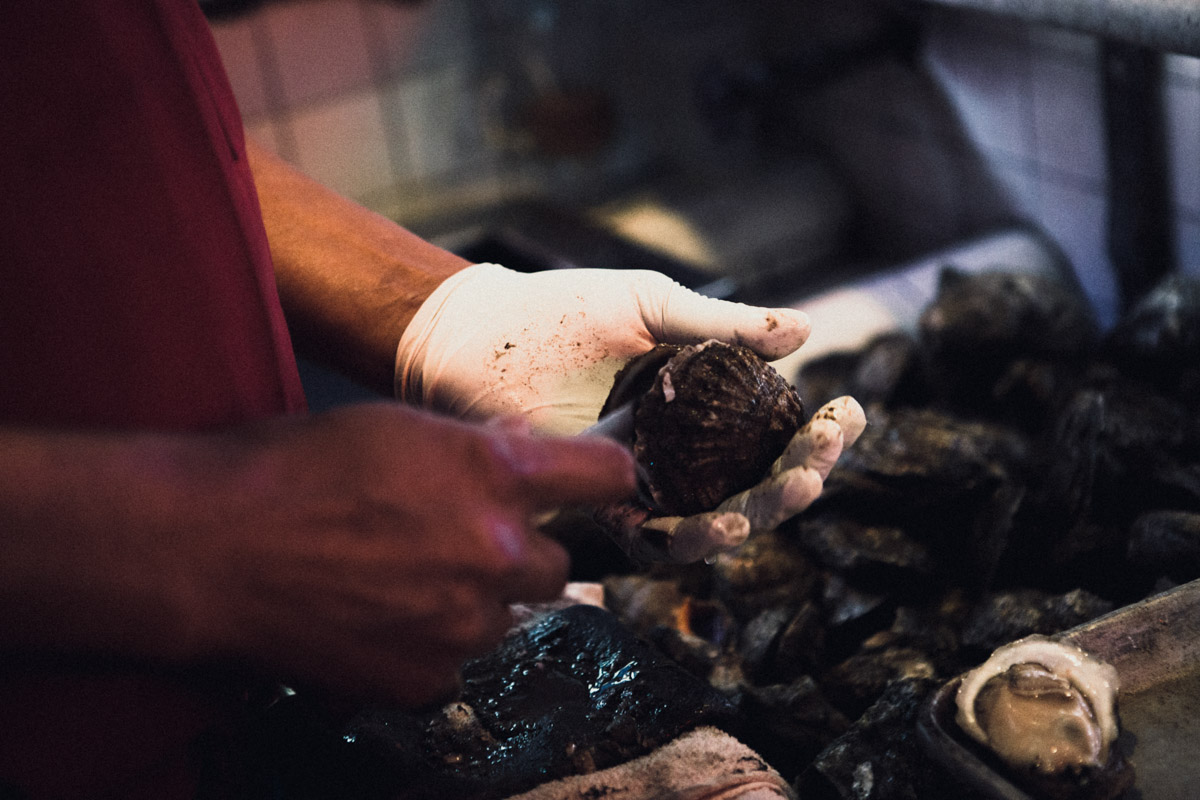
In 1979 the Vietnam war was over, poverty was high and crime was low and Norman Conerly was looking for a job. As a seventeen year old black male with no college education he had few opportunities in Southern Louisiana, and the two most obvious were restaurant employment or military service. Initially he opted for military service but he got sick and was unable to follow through with his plan to join. Instead, he went in search of a restaurant job. Going to work in a kitchen made as much sense as anything else and when he heard that the venerable Hotel Monteleone was opening an oyster bar he was all in. At the time Acme Oyster House had been going, if not always strong, for eighty years, but putting an oyster bar in a fancy hotel was on oddity. He had always done well with his hands playing music, doing carpentry and painting and he suspected working in restaurants—especially an oyster bar—would come naturally as well.
He signed up and lined up. The manager gave him a knife and he started to shuck. No instruction. No gloves. He was hired and he uses the same technique then as today.

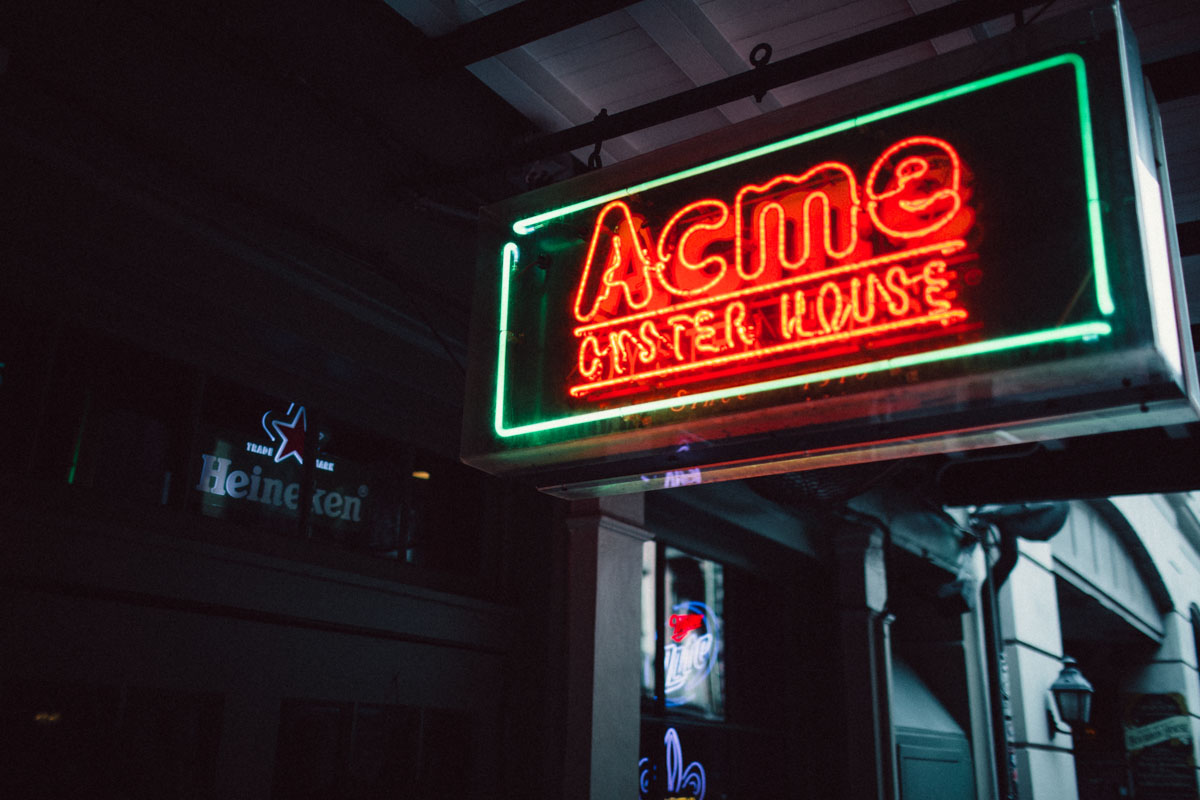
He starts with the classic white handled oyster knife with a fat plastic handle and a long flat blade with only a slight point at the top. He picks up an oyster and confirms that it is alive by taping it on the top shell. A hollow sound means the oyster is dried up and dead. Assuming it is alive, he turns the oyster on its side and rests it on a flat surface. He then slips the blade into the oyster, in between the top and bottom shells, near the front of the oyster, away from the hinge. He gives the knife a twist separating the top from the bottom of the oyster. (Most people insert the knife into the hinge and give it a twist but Norman prefers the other side.) He then carefully runs the knife along the inside of the top of the shell cutting off the “foot”—the muscle that attaches the oyster to the shell—and tosses out the top of the shell. Then he slides the knife along the inside of the bottom shell separating the oyster from the bottom shell by slicing through the bottom foot. He then uses the knife to remove grit and smooth out the oyster. No rinsing allowed.
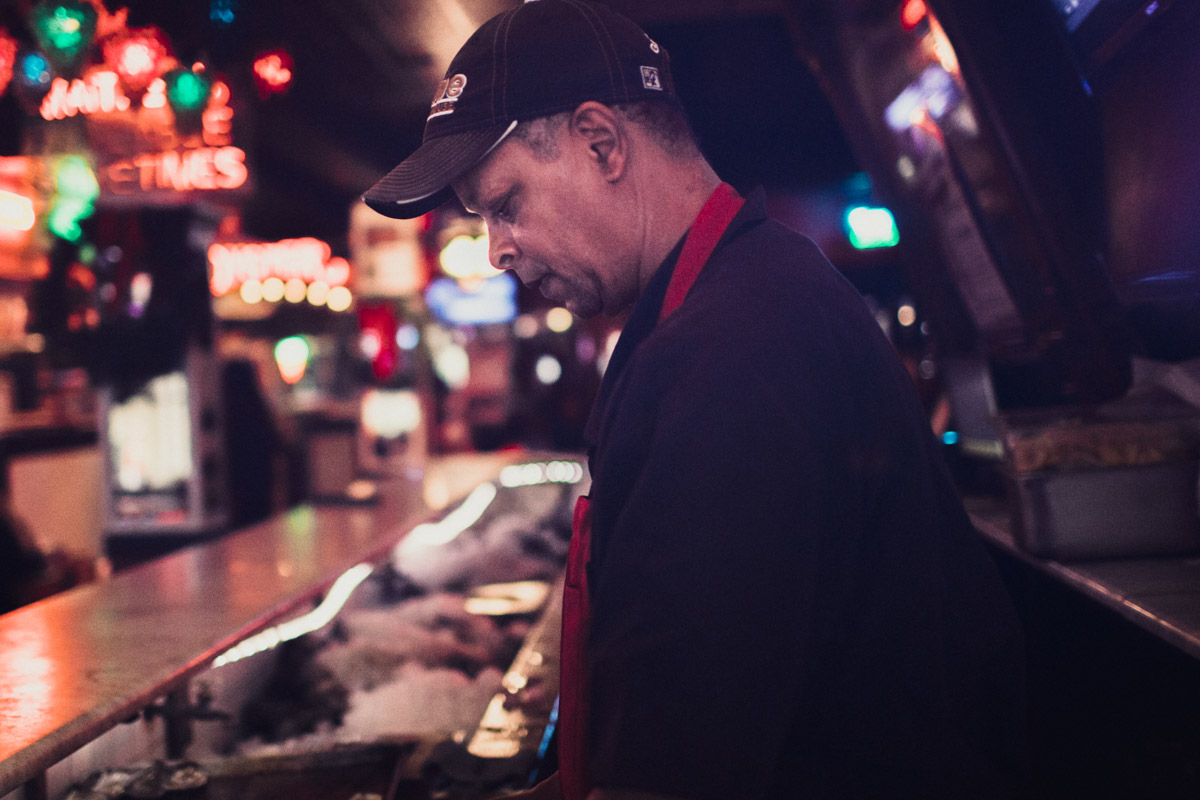
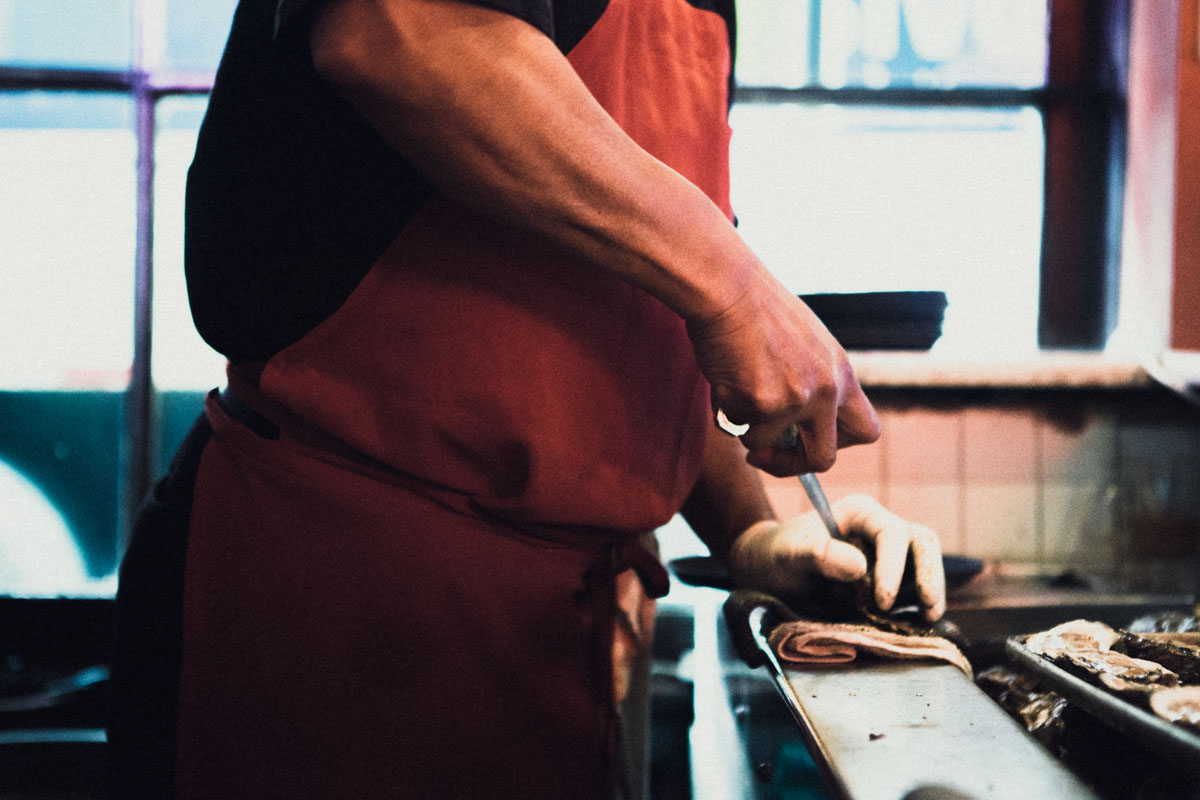
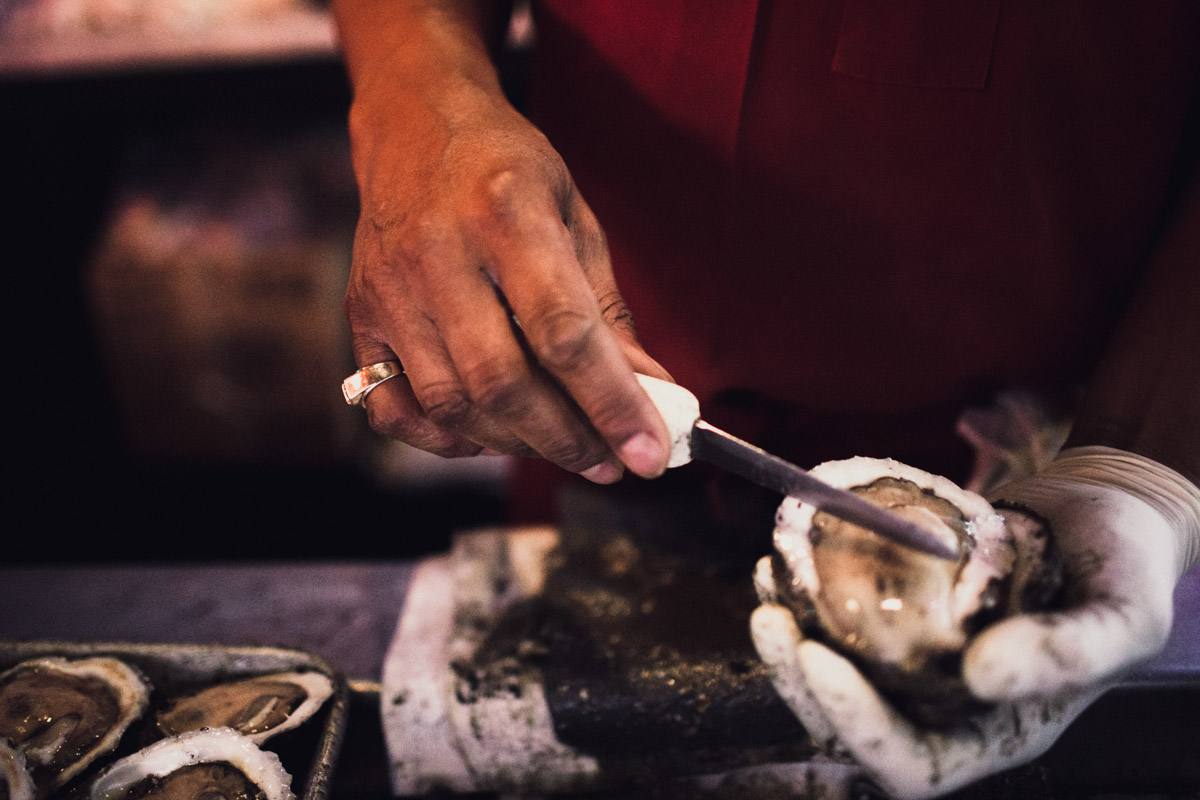
The next step though, he isn’t so keen on. He readily admits that he doesn’t actually eat oysters. The cool slimy and dense globule, just barely dotted with some kind of topping—horseradish, hot sauce, lemon, vinegar or nothing at all—sliding out of its shell and into your mouth filling it with salty seawater making its way up your nasal passages and down your throat simultaneous. You chew… you have to chew… and the bivalve reluctantly gives way, mixing with the hot tang of fresh horseradish or the pickled pepper of classic Tabasco sauce. You swallow, you take a breath, you take a sip of ice cold beer and you go in for another round. Heaven for his customers, but he only does it if he absolutely has no choice. “Like if I’m on television,” he says, as though everyone has to make that sacrifice.
Norman has been at this for thirty-five years but by Acme standards he is a youngster having been there only sixteen years. He figures he shucks about fifteen hundred oysters in an eight hour day, sitting down only at the end of his shift to roll silverware, a task he relishes because he gets to sit. He enjoys his job because he gets the opportunity to meet people, share his story, and travel occasionally. He has been to Washington D.C., Hollywood, New York City and, frequently, gets flown out for private catering jobs around the country for people who have fallen in love with New Orleans oysters and the shuckers who produce them.
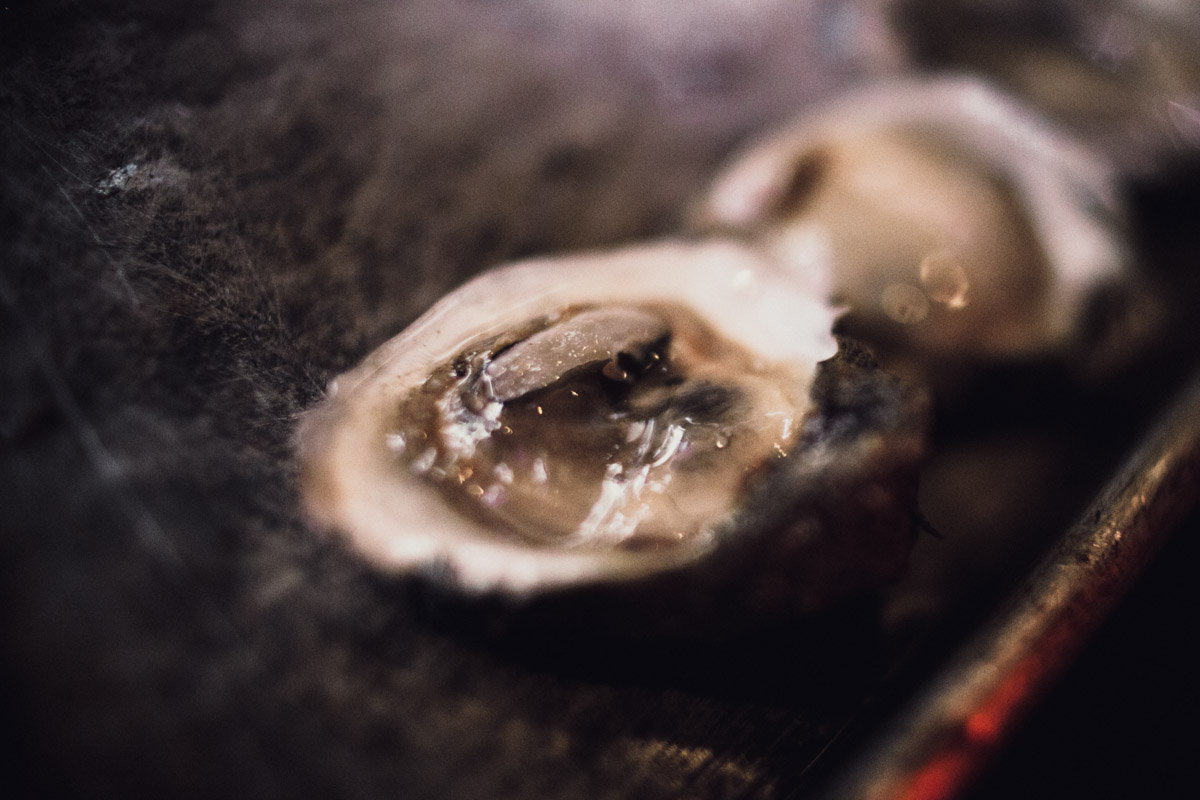
A few days after meeting Norman I return to meet the other Master Shucker at Acme, Michael “Hollywood” Broadway. I arrived at 4:30pm, thirty minutes after his shift began and thirty minutes before the dinner rush would start.
“HOLLYWOOD!” the hostess bellowed into the dining room, a young black man picked up the cry and threw it further into the bowels of the restaurant “HOLLYWOOD! Someone’s here for you!”
Michael “Hollywood” Broadway strode up, stuck his hand out and led me straight back to his station as one of the three shuckers on duty that night.
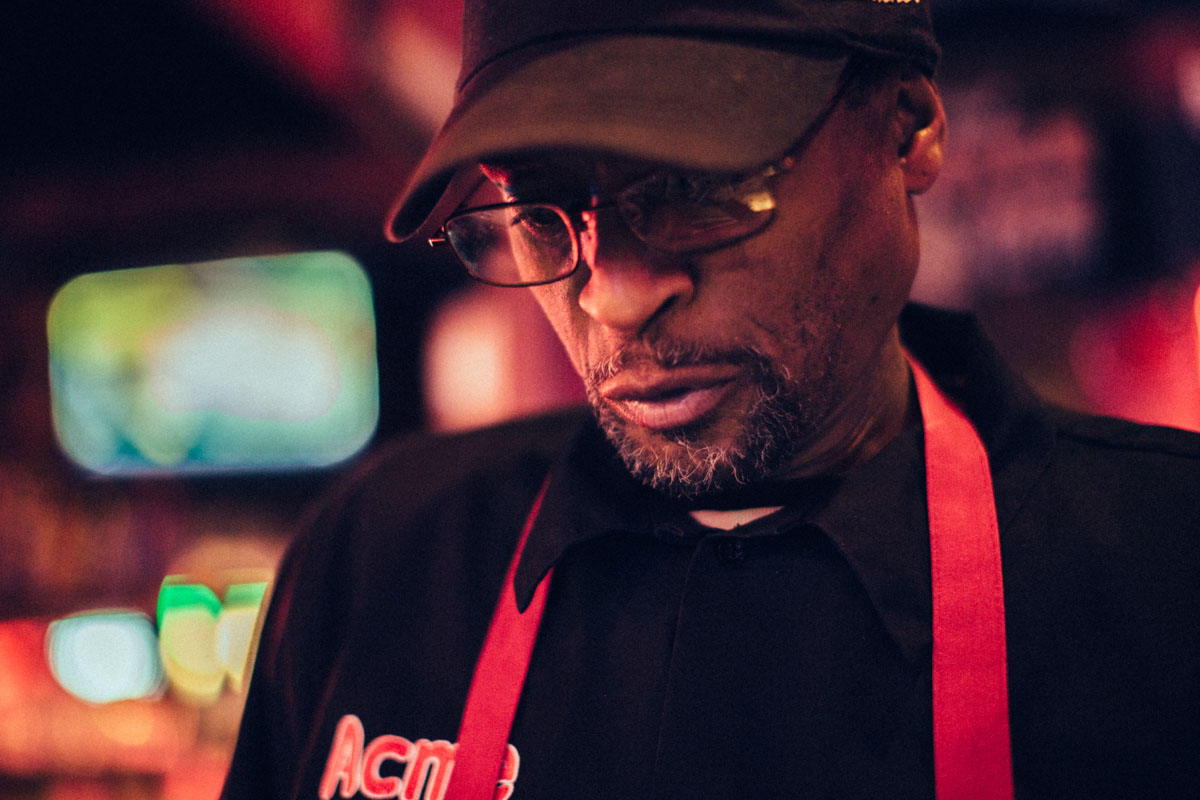
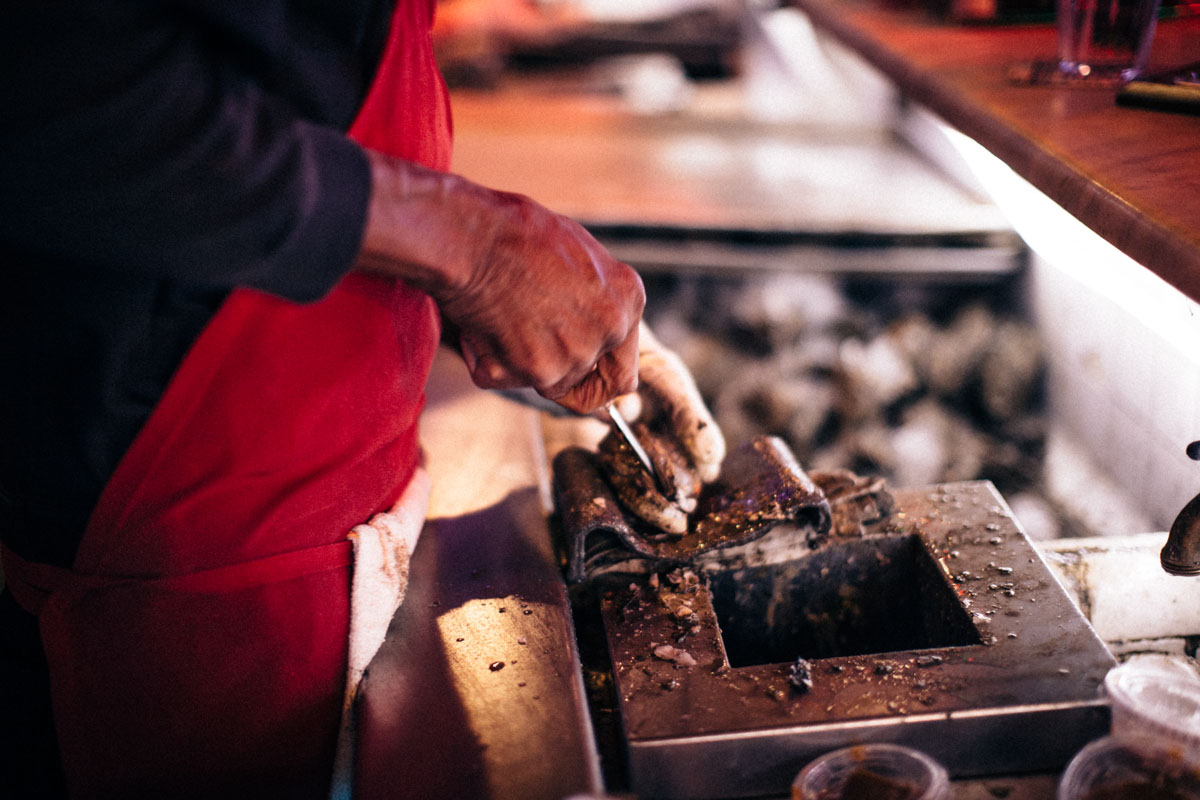
He was quiet and shy to start but once he stood behind the safety of the oyster bar and a sack of oysters he warmed up. The first thing he has to get through each day is the forty or so really difficult oysters that the day crew leave for him. These are ones with multiple oysters clustered together, shells from which it is impossible to tell the top from the bottom, ones that might be dead, might be alive. Oysters that take a full minute to open—as opposed to his usual six seconds. After that the sacks of regular oysters fly by. He picks them up, quick tap again to see if they are alive, then uses his own technique that is similar to Norman’s, if a bit slower.
He picks up an oyster and taps it. Dead. Picks up another and taps it. Shrugs his shoulders and starts to open it. “Should have known, this one is dead too. Sometimes you gotta check.”
He starts his routine with his accolades, “I’ve been all over the place with this job—Washington D.C., New York City, California, and lots of other places. Sometimes they have me compete in shucking competitions but it’s fixed. They’d never let someone from down here win.”
He goes through a string of advice he has for up-and-comers and then he settles down. He shucks. He answers questions and he keeps a close eye on a newbie he’s training who has only been shucking for eleven years and is still quite nervous.
“He just needs to relax. It’s more important to be good than be fast. Be good, and the speed will come.”

How did you get started shucking oysters?
MB: I joined the military in 1979 and before I went in I got my best friend a job at Acme shucking oysters but I made him promise to hold a job for me. Seven years later I returned to New Orleans but went to work at The Hilton. One day I walked by Desire (an oyster bar) and saw the guys shucking oysters outside. They looked like they were having fun so I went to work with them. They would only hire me as a busboy and the shuckers wouldn’t teach me how to shuck. They told me it takes a “real man” to shuck oysters. When they took their smoke breaks, though, they would leave their knives on the oyster bar and I got in the habit of picking up the knives and teaching myself to shuck. Eventually they caught on and they started taking their knives with them but I caught on too and bought an oyster knife and started bringing it with me to work and waiting for them to take a break. Eventually I got the chance to show that I could shuck and he got hired as a shucker.

So what of the “R” month thing. Is that real?
NC: Nah. That’s from back when there wasn’t refrigeration for the oysters and they would spoil on the boat. Now they get harvested and refrigerated right away so they are fine. They are a little milkier during “R” months but there is nothing wrong with that. I doubted him, as I generally doubt anyone with a big stake in a game.
Author’s note: I looked this up and Norman is exactly right. It is no longer dangerous to eat oysters in the warmer months although some oyster purists will still abstain during those months or will switch to oysters from cooler waters.
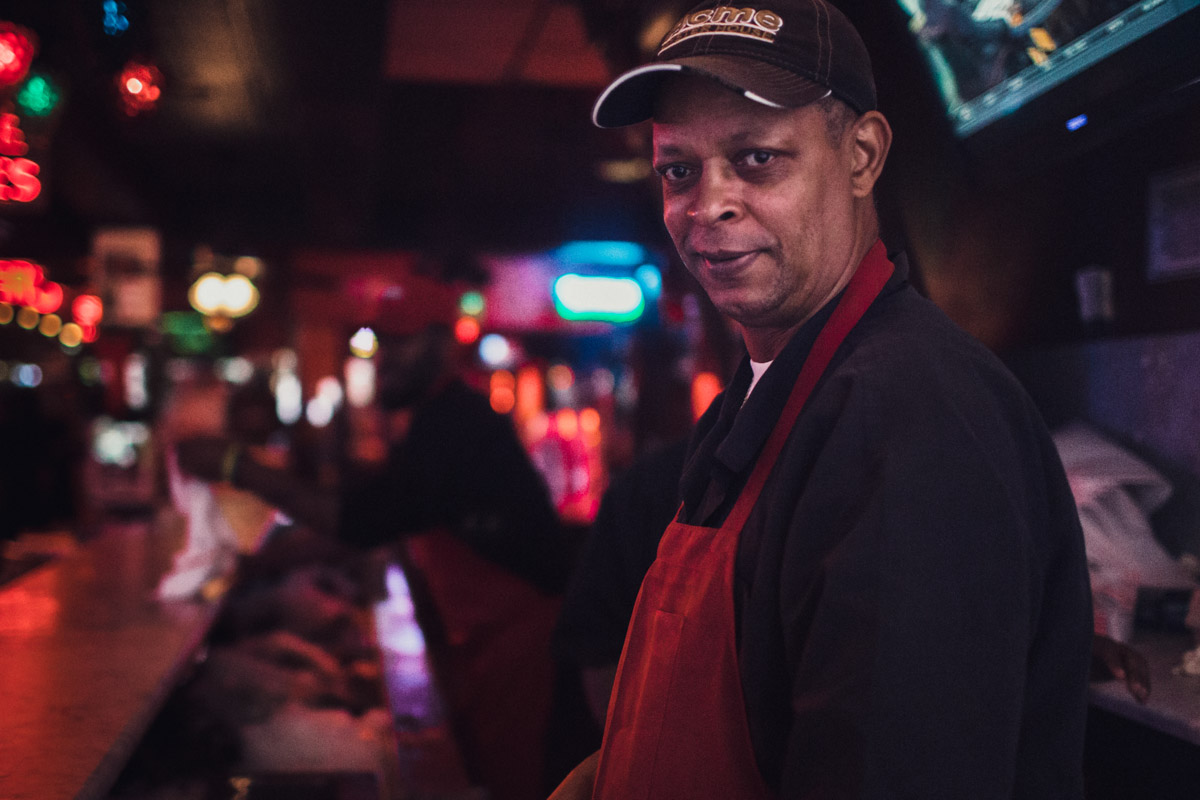
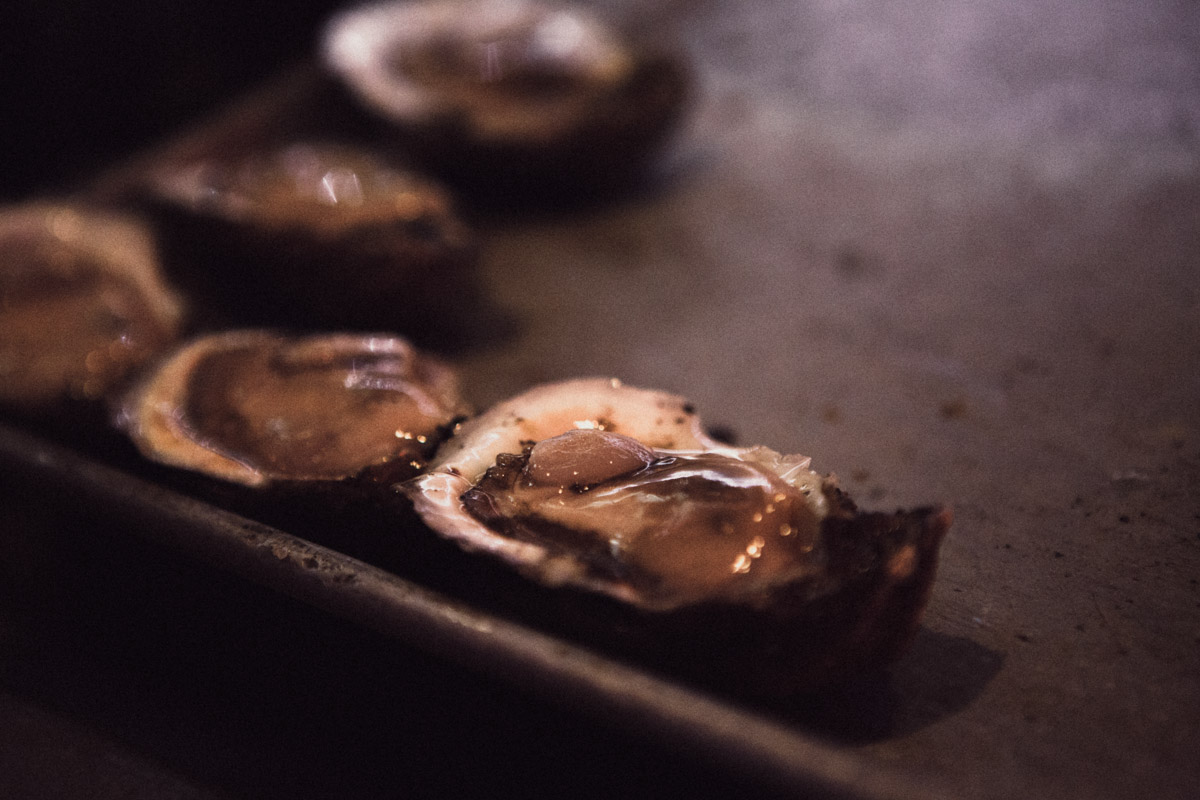
How do you like to eat them?
NC: I don’t. I never really cared for them. I grew up eating them fried but back then seafood was expensive and it was a monthly treat. Now I just avoid them unless I really have to.
MB: I don’t like too much stuff on them because then you can’t taste the oysters. Everyone puts a bunch of butter and cheese and garlic and that’s great but then you might as well just eat butter and cheese and garlic. If you want to grill them just add a small amount of fresh Parmesan and that’s it.
What is your favorite thing to eat?
NC: Whatever you are cooking.
MB: New Orleans food, but I cook it. I cook everything.
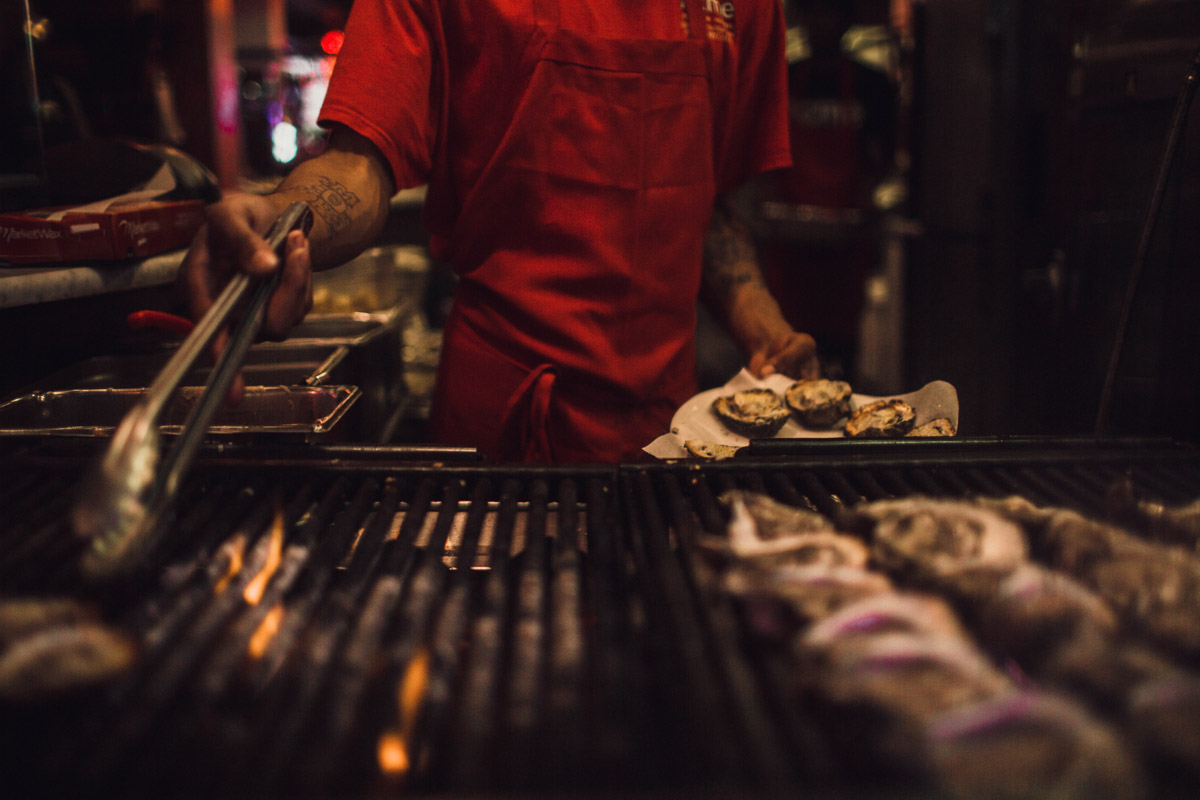
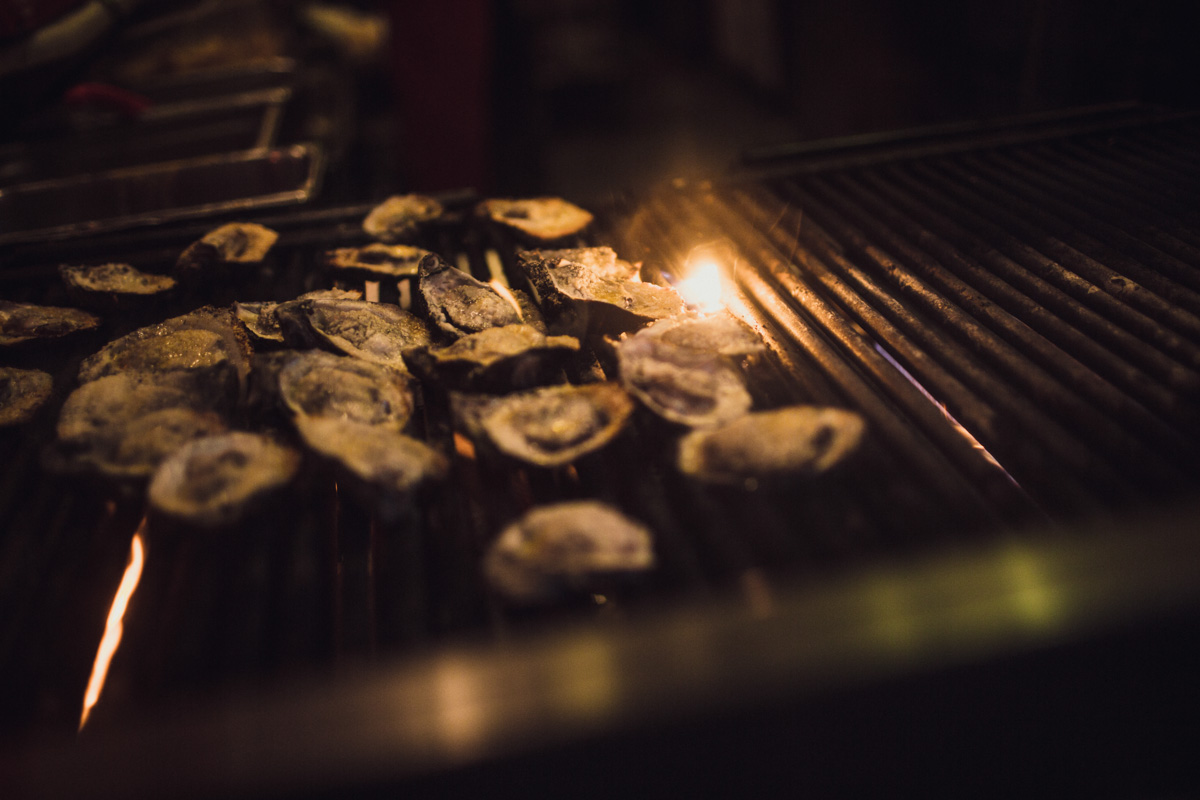
What do you like most about Acme?
MB: They hire and promote from within. Dishwashers turn into porters who turn into bartenders. That builds confidence in the employees. People are happy to be here and happy to work here.
Have you ever thought of another career?
MB: Someone told me once that all I could do was shuck oysters so I went and got a job at the Tulane Burn Unit as a therapist’s assistant training interns. I spent five years before they changed the regulations that therapist assistants needed a license so they had to let me go. I was also an assistant in a nursing home. They were really similar things though and to do that you really have to enjoy it in your heart. It isn’t about the money. I proved that I could do something else and then I went back to just shucking oysters.

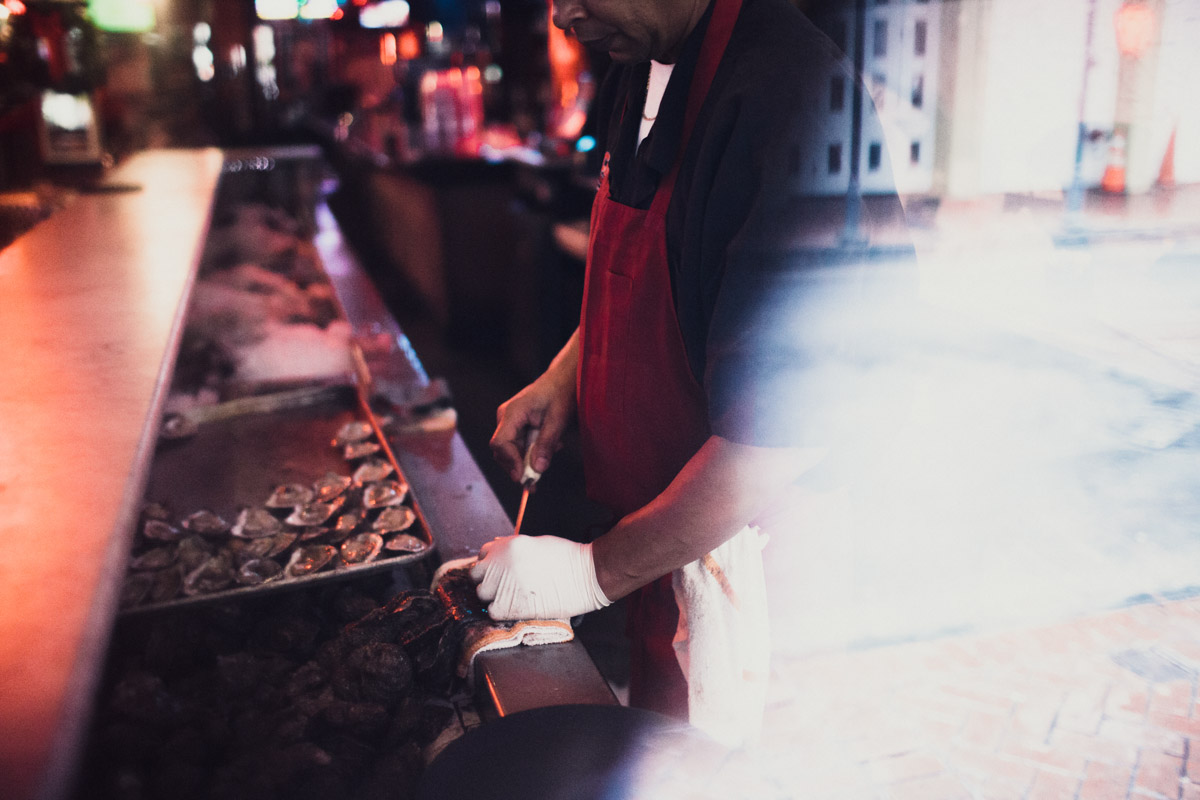
Best Acme Story?
MB: In 1985 Mike Rodrigue had just purchased the renowned Acme Oyster Bar but hadn’t yet made the rounds introducing himself to everyone. He sat down at the oyster bar and asked for a dozen oysters. Then he made me offer: “Throw in a few extras and I’ll give you a big tip.” I said I would. I gave him a thirteenth oyster and said, “I can give you an extra oyster, we call that ‘lagniappe’, but any more than that is called stealing, and that I can’t do.” He loved it. He said, “I like that! I’m the new owner and I appreciate that.” I said, “I don’t care who you are. Giving away more than the thirteenth is stealing.”
Have you ever injured yourself opening oysters?
NC: Yeah, a few times. It happens to everyone but it happens less if you know what you are doing. You can just tell when an oyster is going to crumble and you stop right away. When you do cut yourself you don’t go to the doctor. You just soak it in salt water and it goes away. The bad thing is the mud. You really don’t want the mud in the cut. (His fellow shucker, Steven, agrees with this sentiment.)

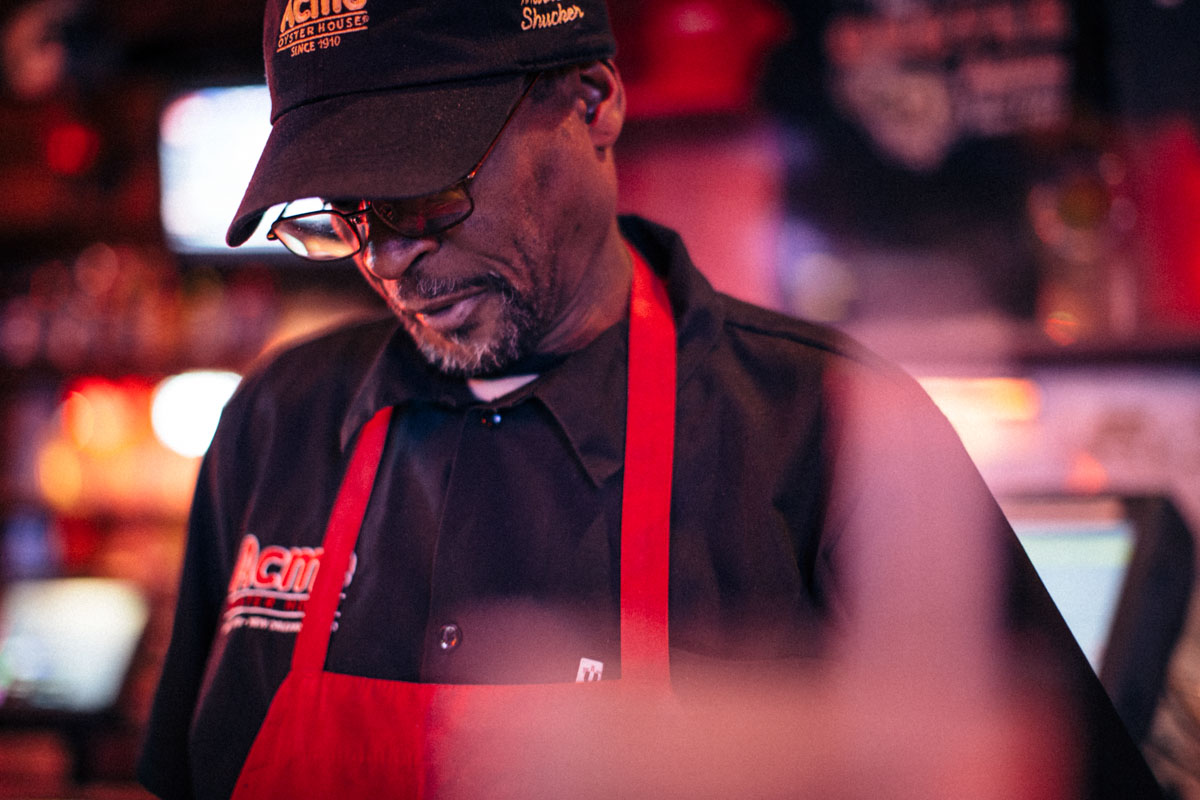
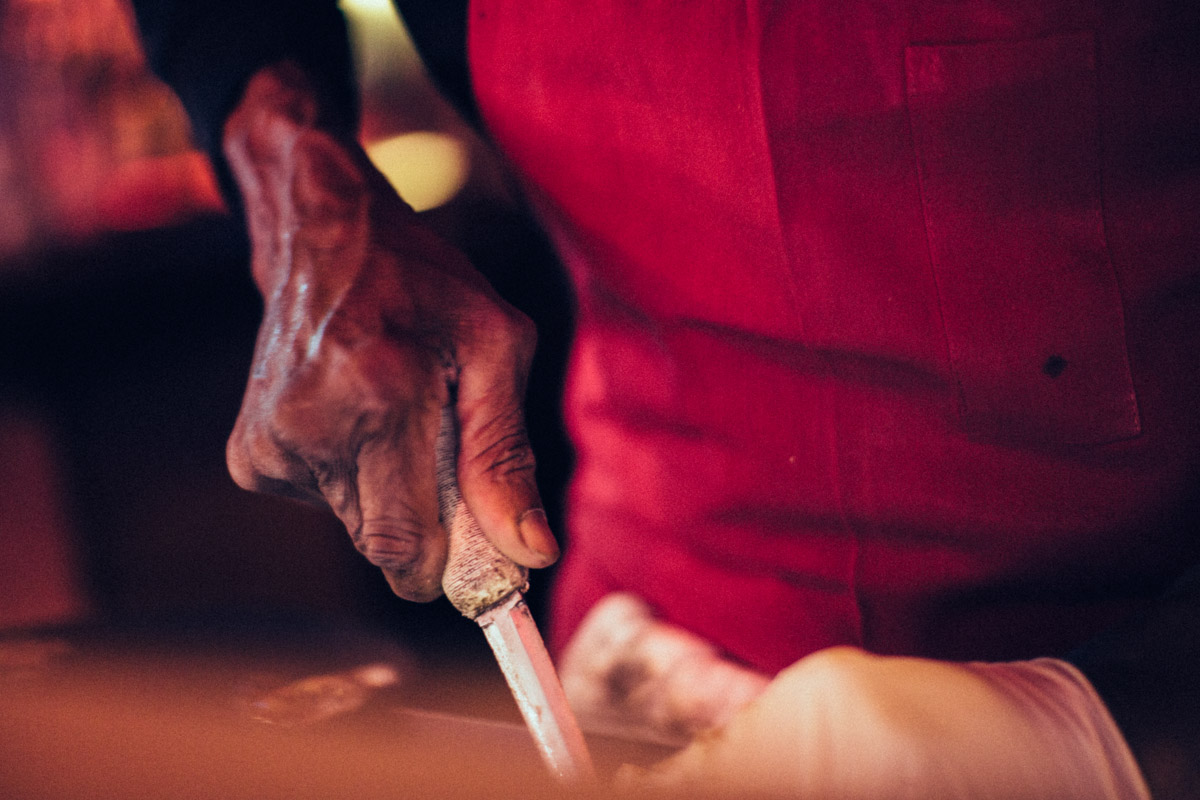
What advice do you give the kids coming in who remind you of you?
MB: Life is all about respect and recognition. The money will come later.
If someone tells you you can’t do something don’t prove them right, prove them wrong and most importantly, don’t work hard, work smart.
NC: The lesson I learned from my mom. Learn to live with what you don’t have. Don’t hold grudges. Oh, and I am allergic to marriage and credit cards.
—
Acme Oyster House
724 Iberville Street, New Orleans, LA 70130

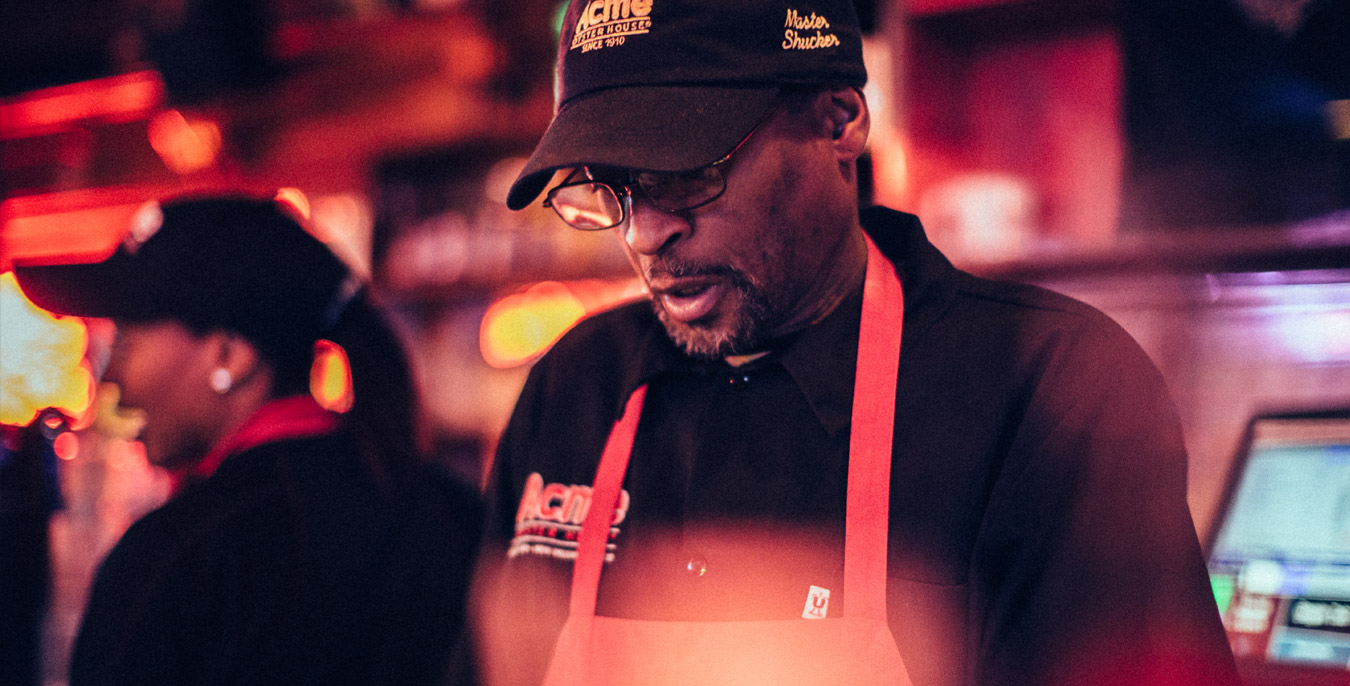

Our comments section is for members only.
Join today to gain exclusive access.